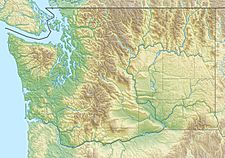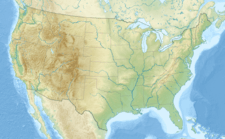Gotchen Glacier facts for kids
Quick facts for kids Gotchen Glacier |
|
|---|---|
| Type | Mountain glacier |
| Coordinates | 46°09′49″N 121°28′24″W / 46.16361°N 121.47333°W |
| Area | 0.17 km2 (0.066 sq mi) in 2006 |
| Length | .20 mi (0.32 km) |
| Terminus | Talus |
| Status | Retreating |
Gotchen Glacier is a cool river of ice found on the south side of Mount Adams. This mountain is a large stratovolcano, which is a type of volcano shaped like a cone. It's located in the Gifford Pinchot National Forest in Washington, USA.
This glacier flows down from about 8,200 ft (2,500 m) high to around 7,400 ft (2,300 m). At its end, called the terminus, you can find an old pile of rocks and dirt left by the glacier. This pile is called a moraine. There's also a lake formed by the melting ice, known as a proglacial lake.
Contents
What is Gotchen Glacier?
Gotchen Glacier is a type of glacier that forms on mountains. It's made of snow that has fallen and been compressed over many years, turning into thick ice. Glaciers move very slowly, like a frozen river. They can shape the land around them as they slide.
Where is Gotchen Glacier Located?
Gotchen Glacier is on the southern slopes of Mount Adams. This mountain is a big part of the Cascade Range in Washington state. The area is protected within the Gifford Pinchot National Forest. This forest is known for its beautiful scenery and outdoor activities.
How Gotchen Glacier is Changing
Glaciers like Gotchen Glacier can grow or shrink over time. When a glacier shrinks, it's called retreating. Gotchen Glacier has been retreating for more than 100 years. This means it's getting smaller.
Why Glaciers Retreat
Between 1904 and 2006, Gotchen Glacier lost a huge amount of its size. It lost 78 percent of its surface area. This retreat is often linked to changes in climate, like warmer temperatures. When temperatures rise, more ice melts than new snow can replace.
Features of the Glacier's End
At the bottom of Gotchen Glacier, you can see signs of its past. The moraine is like a natural wall of rocks and dirt. It shows where the glacier's end used to be. The proglacial lake is a body of water that forms when the glacier melts. These features help scientists understand how glaciers change over time.



